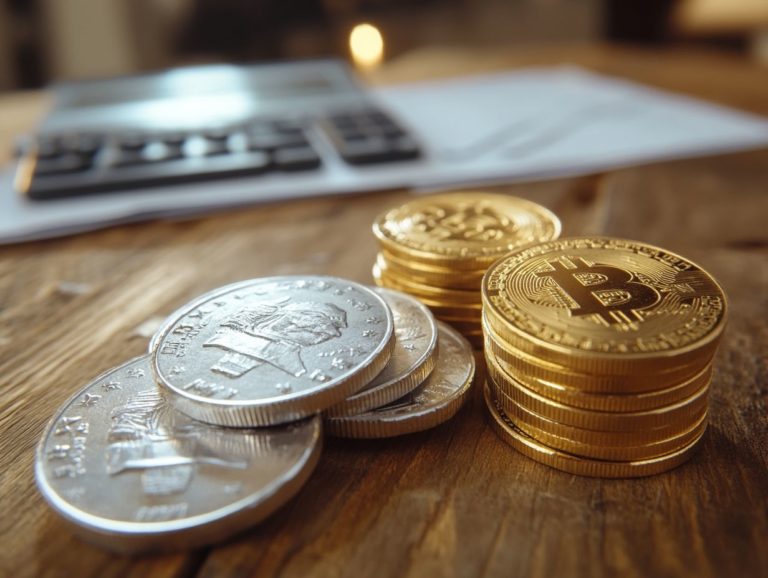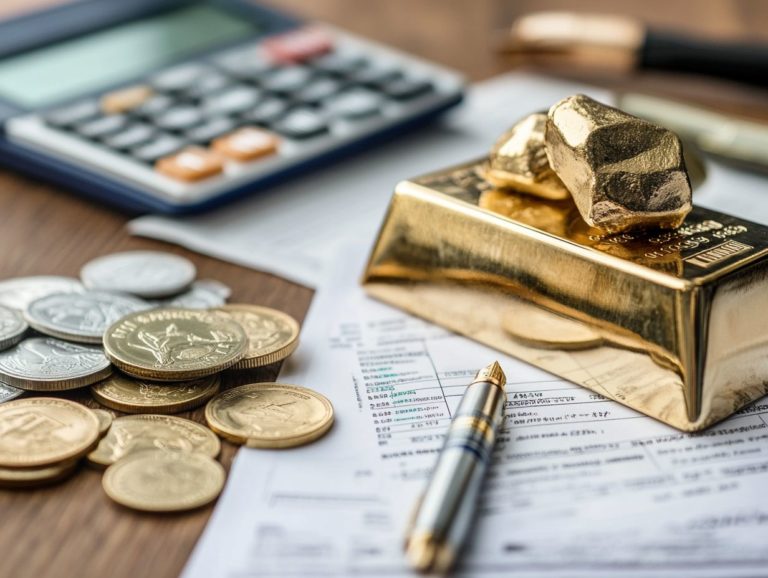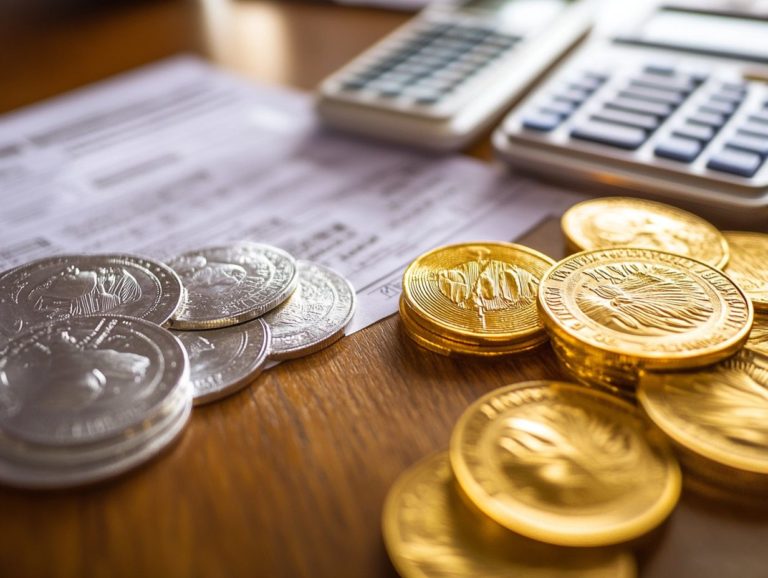Tax Planning for Precious Metals in a Diversified Portfolio
Investing in precious metals can be a savvy move for enhancing your diversified portfolio, providing both stability and the potential for growth.
As you navigate the intricacies of tax implications and strategies, understanding capital gains tax the tax you pay on the profit when you sell an asset for more than you bought it and IRA contributions becomes essential.
Get ready to dive into the exciting world of tax planning for precious metals! This article highlights effective strategies, like timing your purchases and leveraging tax-advantaged accounts.
You ll also explore how to diversify with other assets, weighing the benefits and risks involved. Prepare to elevate your investment strategy!
Contents
- Key Takeaways:
- Tax Considerations for Precious Metals
- Strategies for Tax Planning with Precious Metals
- Using Tax-Advantaged Accounts
- Diversifying with Other Assets
- Alternative Assets to Consider
- Frequently Asked Questions
- What are the tax implications of holding precious metals in a diversified portfolio?
- Can I deduct losses from precious metals in my diversified portfolio on my taxes?
- Are there any tax strategies specifically for reducing taxes on precious metals in a diversified portfolio?
- How does the type of precious metal impact the tax treatment in a diversified portfolio?
- Are there any tax reporting requirements for holding precious metals in a diversified portfolio?
- How can I incorporate tax planning for precious metals in my overall portfolio strategy?
Key Takeaways:
- Diversifying your portfolio with precious metals can provide a hedge against market volatility and inflation, but it’s important to consider the tax implications.
- Capital gains tax and IRA contributions can impact tax planning strategies. Timing purchases and utilizing tax-advantaged accounts can minimize tax liabilities.
- Diversification is crucial for managing risk. Precious metals add value, but consider other alternative assets for a balanced portfolio.
What are Precious Metals?
Precious metals like gold, silver, platinum, and palladium hold significant value due to their intrinsic worth and investment potential. For centuries, they’ve served as reliable means of wealth preservation and asset protection, often acting as a hedge against inflation and market fluctuations.
As an investor, you may find that these physical assets offer valuable diversification for your portfolio, making them a favored choice for enhancing your financial stability and growth prospects.
Throughout history, from ancient civilizations to today’s modern economies, precious metals have maintained a distinguished status as symbols of wealth and economic resilience. Their rarity and durability elevate their desirability across various industries, including electronics, automotive, and jewelry.
Along with their industrial uses, many investors consider these metals safe-haven assets during turbulent times, offering a way to protect wealth against economic uncertainties. As alternative investment strategies gain traction, integrating precious metals into your portfolio can be a wise decision, safeguarding your assets while also positioning you for potentially impressive returns.
Why Include Them in a Diversified Portfolio?
Including precious metals in your diversified portfolio is essential if you re looking to mitigate the risks that come with market volatility and inflation. By allocating a portion of your investments to these precious metals, you can achieve better asset protection and enhance your overall financial strategy.
This kind of diversification often leads to more stable investment returns, as precious metals tend to retain their value during economic downturns and act as a reliable hedge against currency fluctuations.
Understanding the role of these metals in your portfolio is crucial for managing your capital gains effectively. For effective strategies, consider the best practices for precious metals investment. Historically, precious metals have shown remarkable resilience in various market conditions, frequently outperforming other asset classes during times of financial uncertainty.
This unique characteristic allows them to function as a safety net, providing a buffer against unpredictable market shifts. By including gold, silver, or platinum in your investments, you can help balance risks while potentially boosting your returns.
These metals typically have a low correlation with stocks and bonds, making them an excellent choice for enhancing your overall portfolio performance. As a result, discerning investors recognize that integrating these commodities is pivotal to achieving a well-rounded investment approach.
Tax Considerations for Precious Metals
When you invest in precious metals, grasping the tax implications is essential for effectively managing your tax liabilities and optimizing your returns. Capital gains tax can weigh heavily on the overall profitability of your precious metal investments, making tax planning a vital component of your investment strategy.
The IRS has specific regulations concerning the taxation of precious metals, and staying informed about these can enable you to make savvy decisions while ensuring compliance with tax laws. Therefore, seeking guidance from a tax professional can offer you invaluable insights to navigate this complex terrain, especially regarding tax planning for precious metals in your portfolio.
Capital Gains Tax on Precious Metals
Capital gains tax on precious metals is a critical consideration for investors. Understanding this tax is essential for accurately assessing profitability and tax implications. When selling these metals for a profit, you may encounter capital gains tax, which can fluctuate based on various factors. These include the holding period, the specific type of metal, and current IRS regulations.
Recognizing how these taxes apply enables you to make informed decisions about the timing of your sales and the overall management of your investment returns.
Different types of precious metals, such as gold, silver, and platinum, have unique tax rates. Collectibles, like coins, often attract even higher rates. It’s crucial to understand the difference between short-term and long-term capital gains, as this can significantly influence your tax liabilities.
Short-term gains, arising from assets held for less than a year, are taxed at ordinary income rates, while long-term gains, from assets held for over a year, are typically taxed at more favorable rates.
To minimize your tax liabilities, consider these strategies:
- Tax-loss harvesting: Selling assets that have lost value to lower your tax bill.
- Exploring tax-deferred accounts: Utilizing accounts that allow you to defer taxes.
- Donating appreciated metals to charity: This supports a worthy cause and may help you avoid capital gains tax altogether.
IRA Contributions and Taxes
Using tax-advantaged accounts like IRAs to hold precious metals can enhance your tax efficiency and overall financial strategy. Contributions to these accounts often come with specific tax benefits, allowing you to defer taxes on your gains until you withdraw funds.
It’s essential to understand IRS regulations regarding the types of precious metals eligible for inclusion in IRAs, as well as the necessary tax reporting procedures.
This investment strategy also serves as a hedge against inflation and market fluctuations while enriching your portfolio with diversity. Eligible metals typically include gold, silver, platinum, and palladium, all known for their intrinsic value.
The tax-deferred growth associated with IRAs means your gains can compound over time without immediate tax liabilities. Be mindful of potential penalties when making withdrawals, as this can impact your overall tax situation.
Strategies for Tax Planning with Precious Metals
Effective tax planning with precious metals involves implementing various strategies to minimize tax liabilities while maximizing investment returns.
Tax-loss harvesting can be particularly advantageous, allowing you to offset gains with losses. Understanding the timing of your purchases and sales can also significantly impact capital gains tax outcomes. This underscores the importance of adopting smart tax strategies for your investments.
Timing Purchases and Sales
Implementing effective timing strategies for purchasing and selling precious metals is essential to maximize returns and minimize capital gains tax. Understanding market volatility and recognizing the right moments to buy or sell can greatly impact your profitability.
Strategic planning of your transactions helps optimize your tax outcomes and enhance portfolio performance. Your timing strategies should be informed by comprehensive market analysis, which involves evaluating historical trends and key economic indicators.
These insights illuminate current market conditions and help identify patterns that could signal future price movements. Pay attention to factors such as inflation rates, currency fluctuations, and geopolitical events, as these play a vital role in shaping market trends.
By keeping a close watch on these economic signals, you can make informed decisions that align with your financial goals, honing your ability to time your investments effectively and capitalize on potential market shifts.
Using Tax-Advantaged Accounts
Using tax-advantaged accounts like IRAs and 401(k)s can enhance your investment game, especially if you’re looking to add some precious metals to your portfolio. These accounts allow for tax-deferred growth, maximizing your investment returns without facing immediate tax consequences. Grasp the specific rules and regulations governing these accounts to effectively blend precious metals into your overall investment strategy.
Take, for example, a self-directed IRA. This type of retirement account lets you manage your investments, allowing you to purchase physical gold, silver, platinum, and palladium assets that can act as a hedge against inflation. Understanding the effect of tax policy on precious metals investment strategies is crucial, as the tax perks include deferring taxes on gains until you take distributions, which can significantly boost your long-term profitability.
Be aware of the limitations, such as stringent regulations concerning the type and purity of metals you can hold, along with penalties for early withdrawals. Thoughtful planning is essential to ensure that your precious metal investments align with your broader financial goals, complementing traditional asset classes while providing much-needed diversification and stability. For example, consider exploring tax strategies for precious metals in a diversified portfolio, especially in uncertain markets.
Diversifying with Other Assets
Diversifying your investment portfolio with assets beyond just precious metals is crucial for effectively managing risk and enhancing your overall financial strategy.
By blending a variety of asset classes such as stocks, bonds, and alternative investments you cultivate a more robust portfolio capable of weathering market fluctuations.
This thoughtful diversification opens the door to additional growth opportunities and helps cushion against potential losses, promoting a well-rounded investment approach.
Benefits and Risks of Diversification
Understanding the benefits and risks of diversification is vital for you as an investor aiming to build a robust investment strategy that includes precious metals. Diversification can significantly enhance asset protection and help mitigate risks linked to market volatility, but it may also introduce complexities in managing a broader portfolio.
Weigh these factors carefully to optimize your investment returns while maintaining a balanced approach.
By diversifying your investments across various asset classes such as equities, real estate, and precious metals you reduce your overall exposure to any single economic event. This strategy lowers the risk of significant losses and may lead to improved returns, as different assets often react differently to market fluctuations.
However, remain cautious of over-diversification, which can dilute potential gains and complicate management. Striking the right balance enables you to harness the benefits of diversification without compromising your portfolio’s efficiency, ensuring effective wealth growth across various economic conditions.
Alternative Assets to Consider
Along with precious metals, consider a variety of alternative assets to elevate your portfolio diversification. Options like real estate, cryptocurrencies, and other investment vehicles offer unique opportunities for growth and risk management.
Real estate, for example, provides a tangible asset with the potential for rental income and appreciation, though it also presents challenges like market fluctuations and maintenance costs. Meanwhile, cryptocurrencies have gained significant traction, offering high volatility and the potential for substantial returns. However, they come with risks such as regulatory shifts and security concerns that require careful navigation.
Art and collectibles can be intriguing investment avenues, appreciating over time while allowing you to enjoy their aesthetic appeal alongside potential financial gains. By understanding market trends and the unique dynamics of these assets, you can make informed decisions that ultimately strengthen your portfolio alongside your precious metals.
Frequently Asked Questions
Start exploring these investment options today for a stronger financial future!
What are the tax implications of holding precious metals in a diversified portfolio?
The tax implications of holding precious metals in a diversified portfolio can vary based on the type of precious metal and how you hold it. Precious metals in physical form, like gold or silver coins and bars, are typically subject to capital gains tax when sold.
If you hold them in a special account that offers tax benefits, the tax rules change.
Can I deduct losses from precious metals in my diversified portfolio on my taxes?
Yes, you can usually deduct losses from selling precious metals on your taxes. The deduction amount might depend on your total income and the type of loss you incur (short-term or long-term).
Consulting with a tax professional is essential for specific guidance on this matter.
Are there any tax strategies specifically for reducing taxes on precious metals in a diversified portfolio?
Yes, there are tax planning techniques to reduce taxes on precious metals in your portfolio. One method is to hold the metals in a special account that offers tax benefits.
You can also offset gains by using losses from other investments.
How does the type of precious metal impact the tax treatment in a diversified portfolio?
The tax treatment can vary based on the type of metal. For instance, gold and silver are often subject to capital gains tax when sold, while platinum and palladium may be taxed as collectibles.
Always check with a tax expert for details on each metal.
Are there any tax reporting requirements for holding precious metals in a diversified portfolio?
Yes, there are tax reporting requirements. If you sell precious metals and realize a gain, you will need to report it on your tax return.
If you have them in a special account, you might need to report those holdings on your tax forms.
How can I incorporate tax planning for precious metals in my overall portfolio strategy?
Incorporating tax planning for precious metals in your overall portfolio strategy is crucial for maximizing returns and minimizing tax liability.
Consider holding them in a special account or selling them strategically to minimize taxes. It’s recommended to consult with a financial advisor or tax professional to develop a personalized tax planning strategy.












